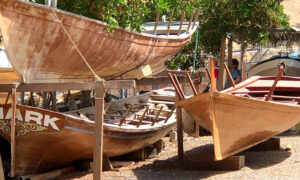
AS I put my Olympus viewfinder up to my eye, I had to move a bit to the left to avoid an elbow and then, oops, someone bumped me from behind and I lost sight of my subject—a sad faced little goat under the arm of a dishdasha dressed Omani who was struggling to make his way around the crowded circle.
Not only was the man holding the squirming baby goat under one arm, but he was pulling another on a rope, all the while, looking for interested buyers.
This was the weekly goat market in the ancient city of Nizwa in Oman. I was on a Photography Tour , organized by the Jim Cline Photo Tours during Feb. 2020, just before the world travel collapsed.

I was intrigued with the idea of attending this event, where farmers and shepherds from surrounding towns, villages and hamlets bring goats and cattle to the market every Friday. I thought the animals would be all lined up in stalls ready and available for purchase.
Hah, Nothing like it. The buyers arranged themselves in a big circle with the sellers, running around in the middle trying to control and to show off their wiggly and bewildered looking goats. It looked to me like a hard way to sell livestock, but somehow it worked.


The restauranteurs or breeders would gesture when interested and the seller would eagerly make his way to show off the goat. This involved examinations of both the mouth and tail end of the goat. Hooves and Ears. It was chaotic. Sometimes a seller had to go against the flow to get to a buyer. You can imagine what that was like with stubborn and confused and often bleating goats.

Sometimes there was haggling and exchange of cash for the goat, but other times, the seller kept going on around the circle looking for another interested buyer, shouting and gesturing to get attention.


We arrived at the market around 9 am just before it got into full swing. It continued all morning. In a world of pre-packaged mass tourism, it was truly a joy to experience an authentic cultural experience like this.
I saw mostly men at the market, dressed in the traditional dishdashas and embroidered caps called kumas. Actually I didn’t see any women selling goats and only one woman out of the 100 or so buying. The women at the market were tourists like me and there weren’t many of us.



Nizwa, is a centuries-old city in northern Oman that was once the country’s capital in the 6th and 7th centuries. It’s about an hour and a half from Muscat, the capital of the country.
I loved the whole experience. It was fun to compare and contrast this experience with the huge Camel Market in Pushkar, India that happens once a year. There the camels and their owners are spread out over huge areas and when a deal is in the offing, the camel buyers and sellers squat down, place a large section of cloth (a turban) over their hands and negotiate with hand signals under cover.
They don’t want anyone to know the deal they are making. Pushkar Camel Festival India.
In Oman, it didn’t seem to matter. I saw exchanges of cash for goats frequently.
The market was a lively place. It not only included the goats and later cattle, but also several shops devoted to many varieties of dates and separate areas and stalls dedicated to birds, produce, crafts, plants, and guns. I poked around around looking at all the stuff capturing images when I could .
Interestingly, I saw very few female shoppers but the men and boys seemed to be having a good time.









Changes with DesignDestinations. org
I have decided to make some changes with DesignDestinations.org Given the lack of travel opportunities and the strange time we are in, it makes sense to me to take the pressure off coming up with original weekly posts.
My plan is to mix older posts with new ones with the goal of continuing to post every Monday.
Please be aware that you can go back and travel the world with me by going to the top of this blog (called the Header) and use the pull down menus to discover what my guest bloggers and I have shared with our readers. We have over 600 posts so you won’t run out of places to visit with us. I hope you enjoy and make comments in the comment section at the end of the blog.
Stay Healthy










Comments
1 Commentwinink60
Aug 5, 2020Interesting! Especially the final photo — I know a LOT of livestock that would simply jump out of that truck!